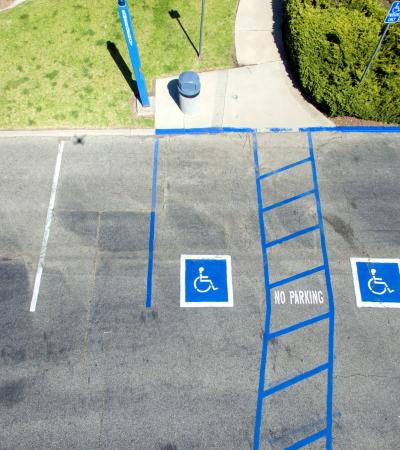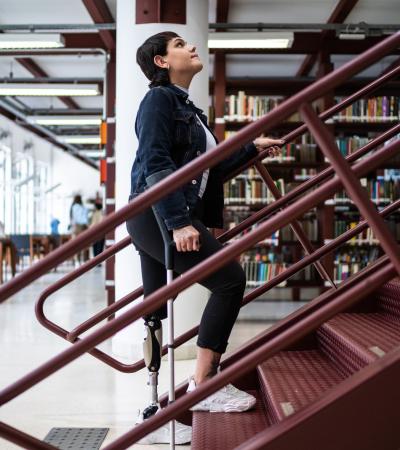As the initiative’s evaluator, we’ve been analyzing grantees’ reports to learn about the partnerships they forged while planning and implementing their projects – and more particularly, how grantees worked with partners to meet the accessibility needs of community members with disabilities. At present, most first-round grantees have finished their projects, and reports from 187 libraries have been made available for analysis.
Grantee libraries worked with a variety of community organizations, and in a variety of ways. Their partnerships proved fruitful in all stages of their accessibility projects – from planning through implementation. Below we highlight some of the many benefits libraries derived through working with community partners.
Project Planning

When devising their accessibility plans, libraries hosted open, public conversations to learn about the most pressing disability-related needs within their communities. The input they received from local residents both inspired and guided their work; one library noted that they “would not have considered” the idea they ultimately adopted “until we started these discussions.” “It simply didn't occur until I talked with patrons," they added.
In addition to gathering feedback from community members, many libraries also consulted with disability-related partners when brainstorming ideas for their accessibility projects. Some libraries consulted with regional chapters of national organizations like ARC, Autism Society, Alzheimer's Association, or Easterseals, while others worked with individual professionals or organizations specific to their area. At times, partners attended community conversations; at others, discussions were held separately. Though the information partners shared was no substitute for speaking directly with community members, libraries found the additional expertise a valuable supplement to community conversations.
In some cases, partners shared what they were doing to make their services accessible to people with disabilities. One library that partnered with a school shared how they “helped us learn how to create adaptive books and social stories,” while also suggesting programs and providing resources. Partners also helped libraries identify accessibility strategies and resources that could be presented as options to community members – or that addressed needs identified by community members. One library described how their community conversation was followed by a presentation from a local author who had founded "a therapeutic farm program for adults with autism and other developmental differences." In addition to sharing details about this program, the partner offered “suggestions on making our library programs more inclusive and welcoming to anyone who may need support or accommodations."
Outreach and Information Sharing
Many libraries found partners valuable in helping spread awareness of their accessibility work. Given the fact that many community members with disabilities were not regular library users, partnerships for information sharing were especially important. Working with local partners enabled libraries to conduct targeted outreach to the populations their proposed projects were meant to help.
Libraries looking to better serve older adults with disabilities often partnered with their local senior centers and assisted living facilities to advertise community conversations and programming. Centers for Independent Living, while typically serving a larger region, were also able to share information about library initiatives with people who might be within the library's service area.
Those whose target audience included children often coordinated with schools for outreach to the families of students with disabilities or neurodivergence. One library spoke of how their school partner "helped us promote what we offer.” In another case, a library praised a school system’s preschool and special education coordinator, saying that this individual was “key to the success of this program. Without her connections,” they added, “we would have had to work longer and harder. But she ran with it – reaching out to her peer network, and connecting with parents, students, and counselors. Having her on board just made everything else fall into place."
Libraries also turned to local government agencies for help with outreach efforts. By forming partnerships with governmental divisions related to disability, aging, or social services at the town or county level, they found new ways to increase awareness of their accessibility projects.
And if there was not a specifically disability-focused group, health departments could still be valuable for outreach, as in the case of a grantee who wrote that "Our Public Health Department and Health and Human Services were both pivotal in helping to get the word out to their clients."
Implementation
At times, partners contributed directly to programs. One library partnered with a local healthcare provider that offered a series of health and wellness programs “at no cost.” These programs became a focal point of the library’s programs, and allowed them to connect older adults struggling with a variety of mental health concerns (including depression, anxiety, and grief or loss) to needed healthcare providers. The library labeled this “one of the biggest successes” of their partnership. Other partners provided programming that parallels libraries’ own efforts. One library described how a group based at a nearby university provided “free training for our First Responders and Families.” Among other things, attendees learned “how to contain a situation” and “how to work with families for best outcomes.”
Partners also provided other forms of assistance with program implementation. One library worked with a partner that helped it carry out a new book delivery project. By adding this new service to their partner’s existing vegetable delivery program, the library was able to expand its patron base and establish an additional means of transporting books and other borrowed materials between the library and community members’ homes. Other libraries appreciated how a partnership offered them alternative sites for programming or event hosting. As an example of this, one library explained how their town’s senior housing “proved an ideal venue for winter programming where participants would not have to deal with harsh winter weather to access activities."
Let’s Put it to Work!
The benefits small and rural libraries experienced working with community partners echo the results we’ve seen elsewhere. In a variety of different contexts, we’ve found that library partnerships can help in terms of:
- Getting the word out about new library programs;
- Offering spaces, resources, personnel, and/or funding to make programs possible;
- Co-planning programs with library staff;
- Sharing their expertise with program audiences as guest speakers or workshop leaders;
- And so much more!
If you're looking to serve people with disabilities in your community, partnerships to consider include:
- Local/regional government councils on disability or aging
- Local chapters of national disability-focused nonprofits (e.g. ARC, Easterseals)
- Independent Living Centers
- Disability advocacy organizations
- Assisted living facilities
- Nonprofits providing services (e.g. meal delivery) or programming (e.g. day programs) to people with disabilities
- Special education/disability services staff at local schools or universities
- Healthcare organizations
Has your library partnered with other community organizations when working on accessibility projects? If so, we’d love to hear from you. What’s worked for you, and how do you think partnering can advance the broader library field’s accessibility goals? To get in touch, send us an email at programminglibrarian@ala.org.
About this Article
This article is part of a series of blog posts exploring how libraries that received funds through ALA's LTC: Accessible Small & Rural Communities are working to better meet the needs of patrons with disabilities. In other posts in this series, we provide a general overview of the accessibility projects these libraries have launched, look at attempts to put the disability rights movement’s ethic of “Nothing About Us Without Us” into practice, consider efforts focused on neurodivergent patrons and older adults, and look at how small and rural libraries are creating accessible community conversations. For more on how libraries can become more accessible to patrons with disabilities, see the collection of resources we assembled. And for more information about LTC, see our historical overview of this initiative.



